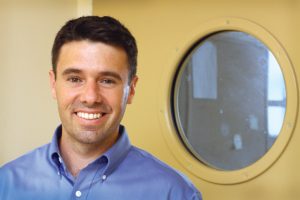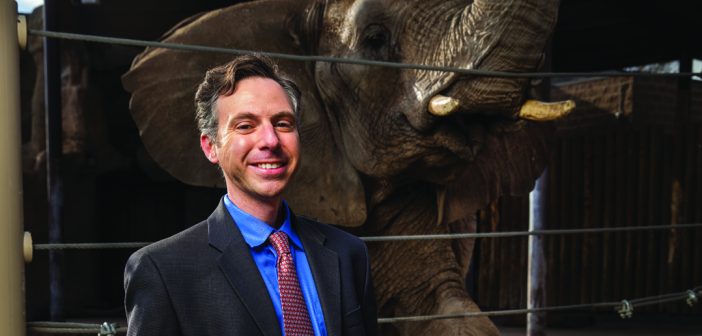Family Matters
Even if you don’t know Schiffman’s name, you may have heard about the elephant study. Published in the Journal of the American Medical Association last October, it was the second most popular JAMA article of 2015, according to Altmetric, and thrust Schiffman, its corresponding author, into an international media spotlight. Virtually every major news outlet covered it, in dozens of languages, and he says he’s still fielding reporters’
calls.
Elephant genetics came to Schiffman’s attention because of his studies of Li-Fraumeni syndrome. Affected individuals have only one working copy of the gene TP53, instead of the usual two inherited from both parents. TP53 codes for a protein, p53, that plays an essential role in cancer prevention by monitoring for genetic anomalies during cell division. “If a DNA mutation occurs in a cell, p53 stops the cell from dividing so it can repair the damage, and if it can’t fix it, it kills the cell,” Schiffman says.
A lack of p53 has been observed in about half of human cancers, including breast, colon, lung, and prostate cancers. Without p53, there’s nothing to prompt the malfunctioning cells to self-destruct and halt their development and metastasis. “Also, as we age, p53 naturally stops working as well as it used to function,” Schiffman says. Even with two copies of TP53, half of men and a third of women will get cancer in their lifetimes. For people with Li-Fraumeni syndrome, the incidence is more than 90 percent.
In 2008 Schiffman, his wife, their two sons (they now have a daughter, too), and their Bernese mountain dog, Rhody, moved to Salt Lake City. There he sees patients at Primary Children’s Hospital, runs a translational research laboratory at Huntsman Cancer Institute at the University of Utah, and serves as medical director of the High Risk Pediatric Cancer Clinic and professor of pediatrics and of oncological sciences. Schiffman has helped to implement a protocol for early cancer detection in children and families with Li-Fraumeni syndrome, and he’s overseeing an effort to sequence the genome of every pediatric cancer patient in Utah to identify risk factors and develop therapies.
Schiffman’s work followed him home and back to the lab again when, shortly after they moved to Utah, Rhody died of cancer. “What are the odds the dog of an oncologist gets cancer?” he says. Unfortunately, pretty good, he learned: purebred dogs develop cancer at 11 times the rate that humans do, and certain breeds, such as Rhody’s, are particularly prone. The loss sparked an interest in comparative oncology—the study of the genomics of human and other animal tumors—and evolutionary medicine.
The evolution of cancer risk “went hand in hand with my focus on familial cancer,” Schiffman says. It was at an evolutionary medicine conference in 2012 that he learned that elephants, which have many times more cells than humans, and many times more cell divisions, can live up to 70 years yet almost never get cancer.
“From an evolutionary perspective, they must be protected against cancer,” Schiffman says. Not only do elephants have 20 times more TP53 genes than humans do, he discovered that when cell division goes awry, rather than stop the process and try to repair the DNA, elephant cells preferentially commit suicide, halting cancer before it can start.
His goals shifted again: “How do we take 55 million years of evolution of cancer resistance [in elephants]and turn it into medicine for people?”
Proteins with a Punch
In 2015 Schiffman traveled to a pediatric oncology conference in Haifa, Israel, to deliver a lecture on elephants, p53, and cancer resistance. In the audience was Avi Schroeder, an assistant professor of chemical engineering at the Technion–Israel Institute of Technology who specializes in novel drug delivery. Schroeder made a note to himself that he had to meet this oncologist from Utah.
Then Schroeder spoke about his work synthesizing proteins and delivering chemotherapy and other drugs via nanoparticles, microscopic spheres that are one-one thousandth the diameter of a human hair, into metastatic tumors. Schiffman wrote a similar note that he must talk to the nanotechnologist. “When we met, we immediately saw this was meant to be,” Schroeder says.

THE VISION: “Our dream is really a world without cancer,” says Avi Schroeder, Schiffman’s collaborator on a new nanomedicine. Photo courtesy Office of the Spokesperson, Technion
Nanomedicines “create accuracy that cannot be attained using larger systems because they are actually able to penetrate into the cancer site,” Schroeder says. (Or as Schiffman puts it, they target the tumor “like heat-seeking missiles.”) About 40 nanotechnology cancer therapies, such as Doxil and Abraxane, are in wide use. But they could do more, Schroeder says. “In cancer medicine we’ve improved a lot,” he says. “The length of life has increased, but today, looking at quality of life in cancer patients, it isn’t as good as you’d actually aspire to have.”
A year of “exciting sleepless nights” has followed that initial meeting, Schiffman says, as he and Schroeder negotiate the nine-hour time difference to collaborate via Skype. “The technical challenge was, could we actually deliver these proteins to the cells of humans that are suffering from cancer and maybe … add functionality to these cancer cells so they would self destroy?” Schroeder says.
They believe they can, and the potential was too exciting to leave to the pace of academic research. “Industry and commercialization move faster than academics,” Schiffman says. “One person with cancer is one person too many. I don’t want to wait 20, 30 years to see this discovery impact people.”
Together, they have founded a startup, PEEL Therapeutics (“peel” is the phonetic spelling of the Hebrew word for elephant), spun off through the University of Utah and Technion. They have synthesized elephant p53, or eP53, proteins and begun to encapsulate them in nanoparticles, and shown proof of concept on human cancer cells in vitro. If they have success in preclinical trials, on animals with cancer, they may release the drug for veterinary use as well. “We have great interest from people who have dogs and pets at home with cancer,” Schroeder says.
(They both stress repeatedly that their labs are not experimenting on elephants, and certainly aren’t giving cancer to elephants, of which they’ve been accused, Schiffman says. “We’re not even asking for any extra blood draws,” he says; the blood they analyze comes from routine draws by veterinarians at Utah’s Hogle Zoo and the Ringling Bros. and Barnum & Bailey Center for Elephant Conservation, in central Florida, whose owner, the Feld Family, is helping to fund their academic research.)
Now the challenge is determining which elephant proteins make the best medicine. “There is something about the individual eP53 proteins and the increased number of eP53 genes turned into proteins that makes them more robust than the two copies of human p53,” Schiffman wrote in an email. “We are trying to learn these answers so that we can choose the correct eP53 protein, or combination of eP53 proteins.” He and Schroeder estimate they’re three to five years away from human clinical trials.
Ed Forman likens the nascent field of nanotechnology to the development of immunotherapy and targeted gene therapy, both of which “exploded” over the course of his career treating cancer patients. “Nano is going to explode,” he says. “It’s a can’t-miss field.”
Schiffman tries to be circumspect. For one thing, he knows that many new drugs will never reach the clinic. “As a clinician, I never want to overpromise and underdeliver to my patients,” he says. “I don’t want to make that claim that I think we have found the wonder drug, the silver bullet, the cure for cancer. What I am claiming is that elephants have figured it out, and now it’s our job to figure out how to apply this to our patients.”




